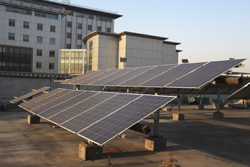Advanced optical layers for thin-film solar cell technology
The EU has set ambitious goals for energy and the environment. A pillar of its policy is the attainment of the 20-20-20 initiative by 2020. This calls for a 20 % reduction in greenhouse gas emissions, 20 % increase in renewable energy contribution and 20 % increase in energy efficiency. PV technology stands to make an important contribution to achieving these objectives, particularly in central European countries and the Mediterranean. However, despite impressive advances in recent years, the industry must further lower costs to make this renewable alternative energy competitive on the free market. Scientists set out to optimise the efficiency and costs of promising PV technologies and demonstrate large-scale production with EU funding of the HELATHIS project. The consortium focused on optical confinement strategies for amorphous silicon (a-Si) and microcrystalline silicon (mc-Si) — state-of-the-art thin-film solar cell technologies currently in the laboratory phase. Project partners identified factors that optimise the properties of the transparent conductive oxide (TCO) layers (optical layers). These layers are present at the front contact and back reflector to maintain efficiencies for large-area deposition manufacturing. In the case of tandem a-Si/mc-Si structures, an intermediate reflector layer was considered as well. HELATHIS demonstrated increased efficiency of its TCO glass through an optimised fabrication process leading to 2 % higher optical transmission. In addition, the whole TCO glass module production was moved from Japan to Belgium, an important addition to the EU economy. 8% stabilized efficiency was demonstrated for very large area 5.7 sqm a-Si modules. A variety of interesting results were achieved in small-scale samples pointing the way to areas for future research. Finally, infrared imaging was developed to assess the electrical quality of each module at the end of the production process and to indicate defective areas. This was applied with excellent success at a partner production line. Project outcomes have fostered industrial-scale production of improved TCO glass within the EU and improved the efficiency of partners' solar cells. Promising advances at the laboratory scale should pave the way for large-area deposition processes with important impact on market uptake of advanced thin-film PV technology.







